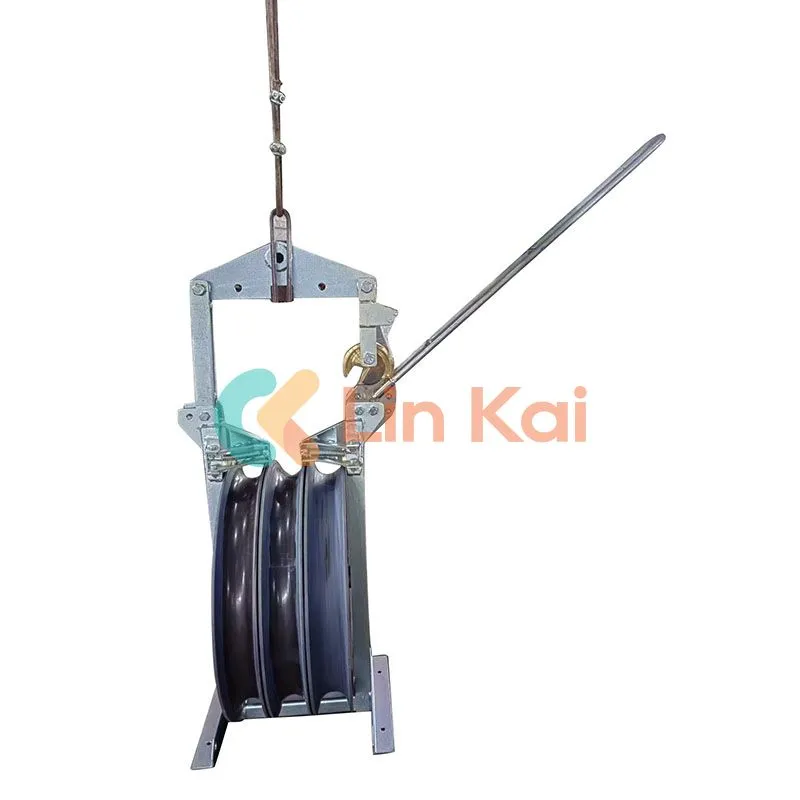The Role of Stringing Blocks in Efficient Power Line Installation
2024-08-30
Introduction
Efficient power line installation is critical for ensuring a stable and reliable supply of electricity. Stringing blocks, with their ability to guide and support conductors, are integral to this process. They help maintain the integrity of the conductors, reduce installation time, and minimize the risk of accidents. In this blog, we will explore the role of stringing blocks in power line installation, discuss the benefits they offer, and provide tips for selecting the right stringing blocks for your project.
The Role of Stringing Blocks in Power Line Installation
Stringing blocks serve several key functions during the installation of power lines:
1. Guiding the Conductor: Stringing blocks guide the conductor along the desired path, ensuring that it follows the correct alignment and does not sag or deviate. This is especially important when navigating complex terrains, such as hills, valleys, or urban areas with obstacles.
2. Reducing Friction: As the conductor is pulled through the stringing blocks, friction is created between the conductor and the block. Stringing blocks are designed to minimize this friction, making it easier to pull the conductor and reducing the strain on both the conductor and the pulling equipment.
3. Preventing Damage: The smooth surface and bearings of stringing blocks help protect the conductor from damage during installation. By preventing abrasion, cuts, and other forms of damage, stringing blocks ensure that the conductor maintains its structural integrity and performance.
4. Supporting the Conductor’s Weight: During the stringing process, the conductor's weight must be supported to prevent it from sagging or breaking. Stringing blocks are designed to handle the weight of the conductor, distributing it evenly across the support structure.
5. Facilitating Tension Control: Stringing blocks allow for precise control of the tension applied to the conductor during installation. This is crucial for maintaining the correct sag and tension in the final installation, ensuring that the conductor operates safely and efficiently.
Benefits of Using Stringing Blocks
Using stringing blocks in power line installation offers several benefits:
1. Increased Efficiency: Stringing blocks streamline the installation process by making it easier to pull conductors over long distances and complex terrains. This reduces the time and effort required for installation, leading to cost savings and faster project completion.
2. Improved Safety: Stringing blocks reduce the risk of accidents by providing a controlled and stable environment for conductor installation. By preventing conductor slippage, damage, and misalignment, stringing blocks help protect workers and equipment.
3. Enhanced Conductor Longevity: By minimizing friction and preventing damage, stringing blocks help extend the lifespan of conductors. This reduces the need for maintenance and replacement, leading to long-term cost savings.
4. Versatility: Stringing blocks are available in a variety of sizes and configurations, making them suitable for a wide range of applications. Whether you are working on high-voltage transmission lines or low-voltage distribution lines, there is a stringing block to meet your needs.
5. Adaptability to Different Terrains: Stringing blocks are designed to handle various terrains and installation challenges. From straight runs to sharp turns and angles, stringing blocks provide the flexibility needed to navigate different environments.

Choosing the Right Stringing Blocks
Selecting the right stringing blocks is crucial for ensuring the success of your power line installation project. Here are some factors to consider when choosing stringing blocks:
1. Conductor Type and Size: The type and size of the conductor being installed will determine the size and type of stringing blocks needed. Ensure that the stringing blocks are compatible with the conductor’s diameter and weight.
2. Terrain and Environment: Consider the terrain and environmental conditions of the installation site. If the project involves sharp turns, steep inclines, or urban areas with obstacles, choose stringing blocks that are designed to handle these challenges.
3. Load Capacity: Stringing blocks must be able to support the weight of the conductor and any additional loads that may be applied during installation. Ensure that the stringing blocks have the appropriate load capacity for your project.
4. Durability and Material: The material of the stringing blocks should be suitable for the environmental conditions of the installation site. Choose stringing blocks made from durable, corrosion-resistant materials that can withstand harsh weather conditions and heavy use.
5. Ease of Installation and Maintenance: Consider the ease of installation and maintenance when selecting stringing blocks
. Choose blocks that are easy to install, remove, and maintain, as this will save time and effort during the project.
Conclusion
Stringing blocks are essential tools for efficient and safe power line installation. By guiding, supporting, and protecting conductors, stringing blocks play a critical role in the success of power transmission projects. Whether you are working on a small-scale installation or a large-scale transmission line, choosing the right stringing blocks and using them effectively will ensure that your project is completed on time, within budget, and to the highest standards of safety and quality. By understanding the role of stringing blocks and their benefits, you can make informed decisions that will lead to successful and reliable power line installations.


